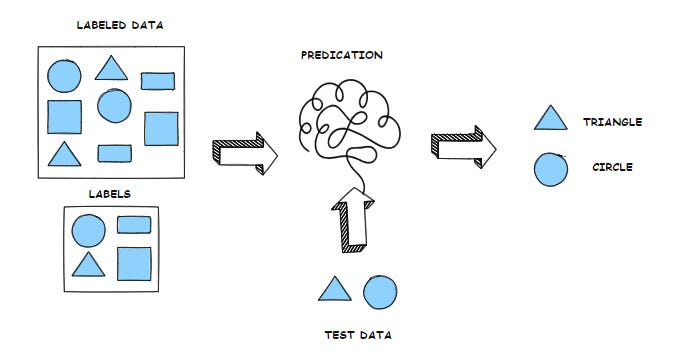- Netomate
- Posts
- How Machines Actually Learn — A Real-World Guide for Curious Engineers
How Machines Actually Learn — A Real-World Guide for Curious Engineers
A beginner-friendly dive into Supervised, Unsupervised, and Reinforcement Learning
Welcome back to our AI Journey. If you are new to here , don’t miss to check previous posts before diving into this post.
In this post , we will talk about “How AI Learns”
Supervised Learning :How we train machine with example with correct answer
Un Supervised Learning: How Machine finds hidden pattern when provided with unlabeled data
Reinforcement Learning :How machine leans by trying things out using feedback
🔍 Supervised Learning :Teaching Machine With Example
Its basically to teach a machine using examples that already have a answers. So we teach model with real example with both input and the correct answers. Over the time ,it starts to get in.
Supervised learning is like teaching someone with flashcard.
Imagine this:
You are sitting with kid showing him flash card of shapes. Each flashcard has a label:
“Square” “Triangle” ” Circle”
Keep showing him flash card over and over.
After sometime , show him flash card having new shape without any label and ask:
“What is this ?
Kid will reply with correct answer may be “Triangle”

That’s supervised learning—you learn from examples that already have answers (labels), and then you try to guess the answer for new stuff.
🎯 Real-Life Example – Predicting House Prices
Okay, Let’s say we are building a model to guess house prices. we provide relevant input to it:
How big the house is
Where it’s located
Number of rooms
...plus what it actually sold for. We keep giving it example after example, and slowly it starts to notice, “Hmm, houses in Mumbai facing Sea go for more. “
Now, if you hand it data for a brand-new house, it can take a decent guess at the price—even if it’s never seen that specific one before.
🌐 How This Works in Networking
Lets consider —network data—we might use this to catch bad traffic.
we train the model on labeled flow data. Stuff like:
IP addresses
Ports
Traffic volume
Protocol used
Packet size
Time of day
Duration
And for each one, mark it “Safe” or “Malicious.”
We do that long enough, and the model starts spotting patterns. “Ah, this combination of port + packet timing? Seen that before. Pretty sure it’s a X”
This is where it starts getting useful—real-time detection, with way less manual effort.
So Why’s It Called “Supervised”?
Simple: because We are literally supervising the learning process. Like showing kid how to ride a bike. We are e right there holding the seat, giving feedback as they go.
It’s not figuring stuff out on its own yet—We are guiding it.
🔍 Unsupervised Learning: When There Are No Answers
So, this one’s bit different. There’s no training, no right answers, nothing. basically give the model a bunch of raw data and say, “Here. Figure it out.”
It’s like landing in a city you’ve never been to—with no map—and just walking around. Over time, you notice stuff: “Okay, everyone gathers near that bus stop,” or “This street’s always jammed during peek hours at 6 PM.” That’s what unsupervised learning does. Finds patterns. Groups.

🎯 Real-life Example – Retirement Savings
Take this—say you’ve got a dataset of people’s ages and their savings. That’s it. No idea who’s doing well, who’s behind. Just raw numbers.
Now, the model might look at it and say, “Hmm, looks like these over-50 folks with low savings—yeah, one group. Then these younger ones saving aggressively? Another group.”
No labels. No judgment. Just clusters. Then a human (like a financial advisor) can come in, look at those clusters, and go, “Yeah, that first group’s in trouble. These others? They’re good.”
🌐 Network Example – Spotting Behavior
Okay, now let’s bring it to networking.
Say you’ve got logs—tons of unlabeled flow data. You dump it into a model. It’s got no clue what “normal” even means, but still starts spotting patterns.
Maybe it figures out that from 9 to 5, traffic looks pretty normal. But then at 2 AM, suddenly some host is pushing massive files to some unknown IP. The model’s like, “That’s not the usual routine.”
Boom. Anomaly detection.
That’s the magic. No one tells it what’s bad—it just sees something off.
🎮 Reinforcement Learning: Learning by Doing
This one’s honestly a gaming. Feels like how we all actually learn.
Reinforcement learning is trial and error, plain and simple. The model does something, sees what happens, and adjusts.
Do something good? Get a reward.
Mess up or wrongly executed ? Penalty.

🎯 Example – Teaching a Game Bot
You’ve got a bot learning to play a game. You don’t tell it the rules. You just give it a little reward when it scores.
You just say,
🟢 “Score point? +1 reward”
🔴 “Lose a life? -1 penalty”
First few rounds? It’s clueless. But it keeps trying. Gets a little better. Tries different moves. Slowly starts winning more.
Eventually it discovers the strategy to win.
Same as how a kid learns. Fall off the cycle? Stay upright?
🌐 Network Example – Auto-Tuning Without the Manual Work
Now, think networking.
Imagine a system that’s allowed to adjust routing paths, bandwidth, QoS settings—whatever.
It tries something new. If latency improves, or throughput increases—reward.
If things get worse—penalty.
And over time? It learns the best combo. Without a human manually tweaking BGP attribute or adjusting buffer size
It’s literally self-tuning. Just like we all do after messing up a few times and figuring things out.

We will talk more about AI in coming posts.
Till time , keep learning !!!!
Smiles :)
Anurudh
Reply